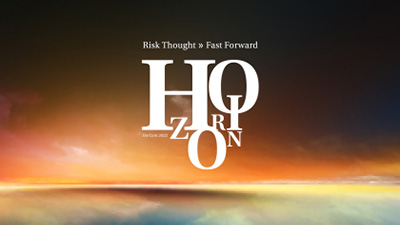… when it comes to the ecological footprint. The current question is: Can risk management contribute to more sustainability, and will the achievement of ESG goals even become a criterion of insurability?
Hardly any company today is not concerned with its ecological footprint. The decarbonisation of production processes and supply chains, the efficient use of energy and the sparing use of valuable resources such as land, water and raw materials are prominent topics on the corporate ESG agenda.
Transformation of the risk landscape
In addition to the challenges and consequences of climate change, other systemic risks are also changing our environment. The opportunities and risks of digitalisation, the effects of Covid-19 on the state, society and the economy, but also the demographic development with the resulting shortage of skilled workers in many industries, are leading to a fundamental transformation of the risk landscape of many companies.
The classic risks consist of tangible assets that can be reported on the balance sheet, such as factories, real estate, machinery and inventory. In 1975, according to an annual study by Ocean Tomo, 83% of the total market value of companies in the Standard & Poor’s 500 stock index was made up of tangible assets. To date, this share is steadily decreasing and was a meagre 10% in 2020. This means that the value of a company today is predominantly composed of intangible assets such as intellectual property, networks, brand values, data and customer relationships. These assets are now largely at risk. Sustainable risk management must take this shift in risk into account. Are domestic companies meeting the transformation of their risk landscape with the necessary attention? Are resources being used in a targeted manner and new solutions for managing and financing these risks being developed, or are they continuing to haggle over percentages at the insurance bazaar in order to pass on the (classic) risks that are receding into the background as cheaply as possible?
Does sustainability change risk?
Today, investments in sustainability are among the most important drivers of innovation. They generate additional growth opportunities and thus contribute to increasing value creation. But what does a company’s sustainability agenda mean for risk and insurance management?
Decarbonisation at the centre
It is clear that investments to achieve specific ESG goals have a direct impact on operational risks. A key issue in the fight against climate change is the decarbonisation of production processes and supply chains. The replacement of fossil fuels with alternative energy sources or carriers is creating new risks in industry. The use of green hydrogen instead of coal in the steel industry or the use of electricity to fire rotary kilns or tunnel kilns poses completely new challenges for business continuity management. The failure of the power supply after a supraregional blackout not only impairs the continuation of operations of many industrial plants, but in some industries also harbours a considerable property damage potential, for example due to the sudden shutdown of automated processes.
For many manufacturers, the recyclability and reusability of the raw materials and materials used is a top priority when developing new products. The sustainability of the supply chains plays a central role here. The requirements for quality management also change when secondary raw materials or completely new materials are used. The product itself and its use becomes the carrier of specific ESG goals. In the textile industry, for example, new materials or processes are introduced to change the properties of the products so that garments need to be washed less often, thus reducing water consumption.
Comprehensive business model
In order to survive in global competition, many companies have expanded their business model. New competences are integrated, and the company is thus positioned as a platform for holistic solutions. In addition, the involvement of suppliers in the implementation of ESG goals is essential. Producers therefore often act as consultants to their own customers in order to contribute their expertise in the area of sustainability along the supply chain. The paper industry, for example, supports its customers in the food sector with innovative solutions for recyclable packaging. All these developments bring with them changed risks in terms of operational and product liability. The expansion of a building materials producer’s value chain through additional services, such as consulting and planning in energy-efficient construction, also leads to new asset loss risks that must be considered in sustainable risk management.
Investments in sustainability can even be interpreted by the insurer as an increase in risk and thus as a disadvantage. Adequate risk and insurance management must make a significant contribution to managing negative risk changes.
The European Commission adopted an ambitious and comprehensive package of measures in April 2021, including the Delegated Regulation on EU Climate Taxonomy, to help channel more money into sustainable activities within the EU. This regulation will enable investors to invest sustainably and contribute significantly to Europe’s climate neutrality by 2050.
First measures by the insurance industry
The insurance industry is also taking the first steps towards climate neutrality. In the Net Zero Insurance Alliance (NZIA) initiated by the United Nations, eight of the world’s leading insurers and reinsurers have committed to individually convert their insurance portfolios to zero greenhouse gas emissions by 2050. Furthermore, due to better capital costs, a greening of underwriting can be expected, which will lead to an increased availability of capacities for sustainably operating companies.
Sustainable risk management
The idea that companies with ambitious ESG targets also represent a better risk for the insurance market is gaining traction. For this reason, there are already first announcements to provide capacity for ESG-performing companies. Statistics clearly indicate that climate change will lead to a significant increase in insured losses from natural hazards. The situation is similar for fire losses, where the share of insured losses from overlapping forest fires will increase significantly.
Conclusion
In a climate-neutral economy, sustainability-based risk management will be an important component of a future-oriented risk management strategy. As a risk specialist, GrECo develops progressive ESG models to increase the resilience of its clients and accompanies them with innovative solutions into a sustainable future.
What is ESG, please?
Environmental Social Governance (ESG) is the umbrella term for the new standard of corporate environmental, social and ethical responsibility. This topic has gained new momentum, especially since the introduction of the UN Sustainable Goals. The three letters ESG describe three sustainability-related areas of responsibility.
E stands for Environment. It refers to pollution, environmental hazards, greenhouse gas emissions and energy efficiency issues.
S stands for Social. This refers to occupational safety, health protection, diversity and social commitment.
G stands for Governance: This refers to corporate values, compliance, steering and control processes and risk management. Each company can determine and weight its ESG goals itself. However, due to the increasing importance of ESG for investors, public pressure on companies is also rising. In the meantime, ESG criteria are also being included in the analysis of securities.
Related Insights
Pillar of Our Strategy Is Specialisation – Interview With Georg Winter
Georg Winter offers some insights into his vision for GrECo. Interview was originally published in Lockton Global Partners Magazine.
‘Our only focus is on our client’s and people’s needs’
Ante Banovac shares his thoughts about future risks facing the insurance industry and the state of the insurance market in Serbia, Slovenia and Croatia
How bad was drought this year in your region and how much insurance would help to protect against losses?
Such a big drought leads to many negative consequences in many industries, especially in agriculture, energy, logistics, and forestry.









